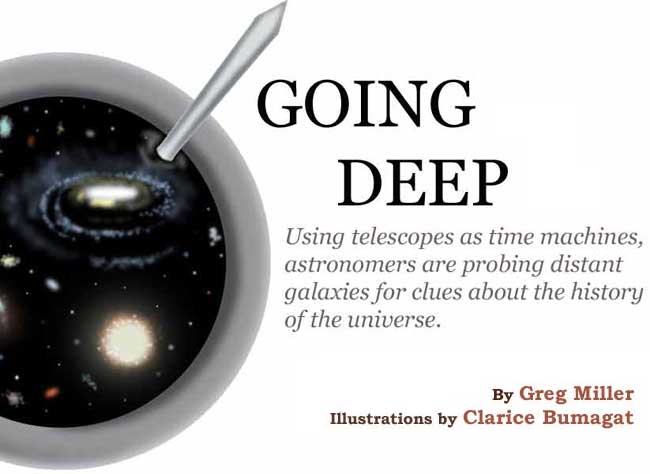


 |
 |
|
 |

 |
If the universe were a soup, it might be the chunky
noodle variety. It certainly would not be a consommé: its matter
is distributed too unevenly, in strings and clumps separated by giant voids.
Stars congregate in galaxies shaped like pinwheels or footballs, which themselves
assemble into massive, sprawling clusters. How did the universe come to look this way? The answer has roots that go all the way back to the Big Bang. The universe expanded wildly in its first split-second of existence, exaggerating minuscule variations of temperature and density into larger pockets that became the seeds of galaxies and voids. Over billions of years, through the action of gravity, the seeds grew into the web-like structure of the modern universe. To understand the processes that created today’s universe, astronomers are training their telescopes on some of the faintest objects in the night sky. These objects include galaxies so far away that the light we see today has taken billions of years to reach Earth. Because of this time lag, the images astronomers see today reflect the way the galaxies looked when the universe was much, much younger. By comparing these distant galaxies to closer, more modern galaxies, scientists hope to learn how the large-scale structure of the universe evolved and how mature galaxies like our Milky Way formed. They also hope to gain new understanding of the mysterious “dark matter” that accounts for at least 90 percent of the universe’s mass and must have influenced its evolution.
Immediately after the Big Bang, the universe was almost perfectly homogenous: a smooth mixture of subatomic particles and dark matter. But as the force of gravity went to work, matter began to clump together, something like scrambled eggs coming together in a frying pan. Then, before the universe was even one second old, it underwent an extreme period of expansion astronomers call “inflation.” In an infinitesimal fraction of a second, it grew by a factor of 1,000,000,000,000,000,000,000,000,000,000,000,000,000,000,000—an expansion roughly equivalent to blowing up a red blood cell to 400 times the size of the sun. Inflation exaggerated the clumps and voids, which continued to grow even as the expansion slowed. Over the next few billion years the inexorable force of gravity condensed the pockets of high density into clouds of gas and dust, and then condensed them even further into stars. At this point the picture becomes a little fuzzy. Did galaxies form as little pockets of stars merged to build up bigger and bigger star clusters? Or did each galaxy start out as a big gas cloud that later condensed to form the galaxy’s stars? These questions fascinate David Koo. Koo comes across as polite and studious—his
office is cluttered with improbably high stacks of books and papers that
form a wall around his desk—but his calm demeanor doesn’t hide
his enthusiasm for his work. Our Milky Way is the spiral type; it has giant arms of stars and gas loosely wound around a central bulge. One mystery Koo would like to solve is how the components of spiral galaxies are assembled. A popular scenario is that they form from the inside out. First, a primordial gas cloud collapses to form a bulge. Then, the flat disk that contains the arms builds up gradually over time. Another possible scenario is that they begin as flat disks, but then form bulges as gravity jostlesthe stars in the center out of position. The Hubble Space Telescope has provided some insight. In 1995 and again in 1998, astronomers programmed the telescope to peer at a single patch of sky for two weeks straight. The resulting images, called the Hubble Deep Fields, provided the sharpest pictures of distant galaxies ever taken. Richard Ellis and colleagues at Cambridge University have studied spiral galaxies in the Hubble Deep Fields for hints about the relative ages of their disks and bulges. Astronomers can get a rough idea of the ages of stars from their colors: newly born stars tend to burn hot and give off blue light, while old stars burn cooler and tend to look reddish. If the inside-out theory is right, the older stars in the bulges should look red, and the newer stars in the disks shouldlook blue. But Ellis and his collaborators found that the bulges tended to be bluer than the inside-out theory predicted. This could mean that the bulges form later than previously thought, or it could mean that the process of bulge formation somehow sparks a wave of new starbirth. The DEEP project will extend Ellis’s study in several ways. First, it will provide a much bigger sample of galaxies: many thousands as opposed to a few hundred. DEEP will also provide additional information about the ages, masses, and chemical composition of the galaxies it samples—clues to the mystery of the bulges. UCSC astronomer Garth Illingworth shares Koo’s interest in galaxy formation, although Illingworth’s own research focuses on elliptical galaxies. These galaxies, which range from football-shaped to nearly round, account for about 70 percent of the mass in the universe, so understanding how they form is an important part of the creation story, Illingworth says. Elliptical galaxies probably resulted from mergers as small, irregularly-shaped, primitive galaxies or even spirals collided. Theorists have predicted this scenario, but it has not been tested rigorously by observation. The Hubble Deep Fields contained a few dramatic pictures of galaxies caught in the act of colliding, providing support for the merger hypothesis. The DEEP project will provide a much larger sample of ancient galaxies, but even more importantly, Illingworth says, it will provide critical information about how galaxies’ masses have changed over time. If the theorists are right, successive mergers should cause galaxies to put on weight as they age. In addition, DEEP should provide insight into the timing of galaxy formation. Some galaxies could have formed as recently as a billion years ago, Illingworth says, but most galaxies probably formed earlier than that, during a flurry of activity that subsequently tapered off as the raw materials—giant clouds of gas and dust—got used up. “The DEEP project is going to be looking at a period between 5 to 8 billion years ago, which is an important range when galaxies were coming into their final phases and building up the objects we see today. There’s a lot happening at that time,” he says.
However, because the time scales involved are so vast, astronomers can’t simply train a telescope on a forming galaxy and watch it evolve. Just as biologists try to piece together the evolution of life on Earth from the snapshots provided by the fossil record, astronomers are limited to comparing pictures of galaxies frozen in time. The DEEP survey, for example, will provide a detailed picture of the universe as an adolescent—just as it was maturing into its current form. This picture will complement more recent photos, like the one being made by the Sloan Digital Sky Survey. The Sloan survey will cover a quarter of the entire sky and will catalog about a million galaxies nearly 2 billion years back in time. The DEEP survey seems modest in comparison: it will cover a patch of sky about the size of eight full moons and will catalog a mere 50,000 galaxies. But the faint light from the distant galaxies presents substantial technical challenges. In fact, a few years ago the project would not have been feasible. The technological advance that made it possible is a new spectrograph, built at UCSC and scheduled to be installed on the Keck II telescope later this year. A spectrograph is the second most powerful tool in astronomers’ collective toolbox, after the telescope. Astronomers use spectrographs as sophisticated prisms to break down starlight into its component wavelengths. This in turn allows them to glean information about what a galaxy is made of, how far away it is, and how massive it is. The spectrograph’s formal name is DEIMOS (short for Deep Imaging Multi-object Spectrograph). Informally, it’s known as “The Beast.” The Beast’s lair, for the time being, is the back room of an engineering shop on the UCSC campus. The spectrograph roughly resembles a cylinder—about 12 feet by 20—with a multitude of wires and instruments sticking out all over. It weighs 6 tons and cost $7 million to make. Andrew Phillips, a postdoctoral researcher at UCSC says DEEP researchers are hoping it will be able to hitch a ride to Hawaii on a military transport plane—the kind used to move tanks. If that falls through it will have to go by freighter. Once DEIMOS is installed on the Keck telescope, astronomers will be able to capture light from more than 100 galaxies at a time. Since DEIMOS can cover a much larger patch of sky than Keck’s current spectrograph, collecting galaxy spectra will go about seven times faster. This improvement is the result of state of-the-art optics and the largest spectrographic detector in the world. The detector, a sophisticated version of the ones found in video cameras, converts light into a digital signal. It covers five square inches—a huge area for this type of device—and contains 67 million pixels. It is so sensitive, Phillips says, that it captures up to 80 percent of the photons that fall on it.. “In astronomy, it’s almost always a problem of gathering enough photons, especially when you want to spread the light out across the spectrum,”he says. DEIMOS will give DEEP an edge on a similar project just getting underway at the European Southern Observatory in Chile, says Joel Primack, a UCSC physicist and DEEP team member. That project, called VIRMOS, will almost certainly catalog a greater number of distant galaxies than the DEEP survey, Primack says. This means their data will provide a more complete picture of how galaxies were distributed throughout the early universe. But the DEEP survey, thanks to the greater sensitivity of the DEIMOS spectrograph, will provide more detailed information about individual galaxies, including their masses. Primack says data from the VIRMOS project will be more useful for understanding how the large-scale structure of the universe has changed over time, whereas the DEEP data should shed more light on the process of galaxy formation. Both projects will provide new opportunities for theorists like Primack to test their computer models of the history of the universe. “The thing that makes cosmology different from stamp collecting is that we have a hope that there’s a simple underlying theory that actually explains everything,” Primack says. The current incarnation of that theory says that more than 90 percent of the universe is made up of mysterious “dark matter,”a fundamentally different kind of stuff than the protons, neutrons and electrons that make up Earth and everything on it. Dark matter is invisible (thus the name), and it interacts with ordinary matter only through the force of gravity. In a very loose way, the dark matter is like the water in the chunky noodle soup: we can’t see it directly, but it must be there because the soup wouldn’t look the same without it. Nobody knows what the dark matter is. Physicists have trotted out a number of candidates, both real and imaginary, from the particle zoo. These particles can be divided into two categories: “hot” (fast-moving) ones such as neutrinos, and “cold” (slow-moving) ones with names like WIMPS, axions and photinos. To test the candidate particles, physicists plug various numbers that describe the attributes of the particles into supercomputer models that simulate the history of the universe. So far, models based on cold dark matter seem to do a better job of producing a universe that evolves in a way that matches observations of the real universe. “Cold dark matter says little things form first, and they’re constantly falling together to form bigger and bigger things,” Primack says. Cold dark matter predicts that spiral galaxies are the first to form, and that elliptical galaxies form from mergers of irregular or spiral galaxies. It also does a better job than hot dark matter of predicting the spiderweb sprawl of galaxies across the sky. However, while some support for the cold dark matter hypothesis has come from previous studies of the distant universe (the Hubble Deep Field, for example), its sternest test is yet to come. The flood of new data from DEEP and VIRMOS may send theorists scrambling back to their dry erase boards and computer models. Like David Koo, Primack is motivated by the quest for a scientific creation story. “Cosmology has long been derided as the branch of science with an abundance of theory and no data,” he says. But in the last 20 years, that situation has changed as astronomers developed more powerful telescopes and better technology. The amount of data has increased exponentially, Primack says, but only cold dark matter theory has survived the flood more-or-less intact. The scientific creation story says, in effect, that we live in a universe made almost entirely of stuff that is not like the stuff our bodies and our planet are made of. We can’t see it and we certainly don’t understand it—at least not yet. Nonetheless, this stuff plays the lead role in the creation, evolution and ultimately the fate of the universe. That is not to say we humans have no role in our own fate, says Sandra Faber, the UCSC astronomer leading the DEEP project. Quite the contrary. Cosmology teaches us that we are “very, very special,” she says. After the Big Bang, it took almost 10 billion years just to make the Earth; then it took more than 4 billion years to create life as we currently know it. What’s more, we have 5 billion years left before the Earth is swallowed up by the death throes of the sun. It’s like having a huge bank account, Faber says. “Think of all we could do in 5 billion years!” But we run the risk of squandering our fortune by destroying our planet, something we have the potential to do in just a few centuries. Faber finds this possibility deeply troubling. People need to know that life-supporting environments like the one on Earth aren’t the norm in the universe, she says. “Astronomy and cosmology are the basic background information the human race needs to plan its future,” Faber says. “When you absorb these facts and picture yourself in the universe, and imagine all the events that took 14 billion years to make you, it changes your whole attitude.”
|
|
Internship: New Scientist magazine, London Internship: pending
Illustrations © 2001 Clarice Bumagat |
 |
 |
 |
 |
 |
 |
 |
 |
 |
 |
 |
 |
 |
 |
 |
 |
 |
 |
 |
||||
 |
 |
 |
 |
||||||||||
 |
 |
 |
 |
||||||||||
ContentsPage | Back to Top | Contact Info. | Science Notes Home